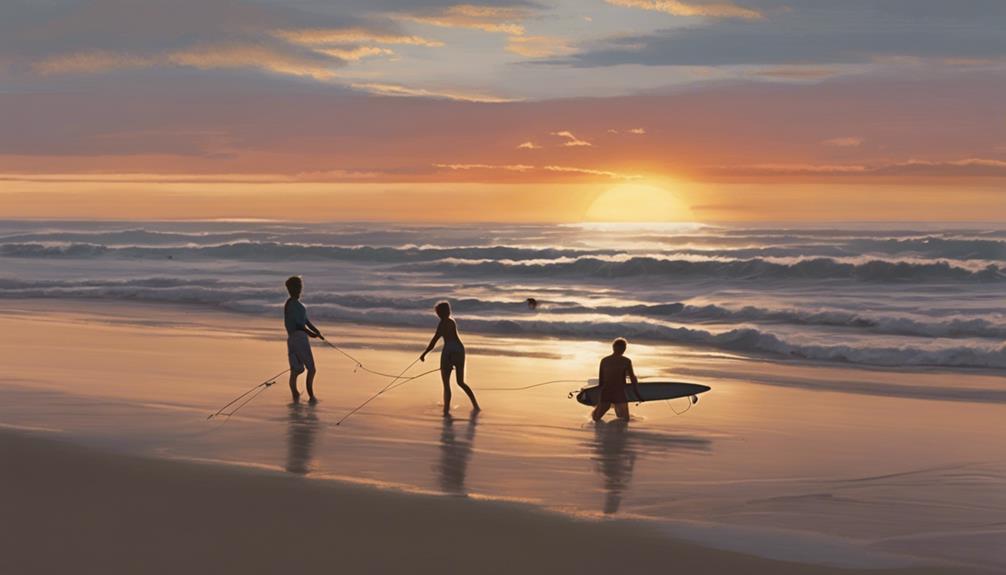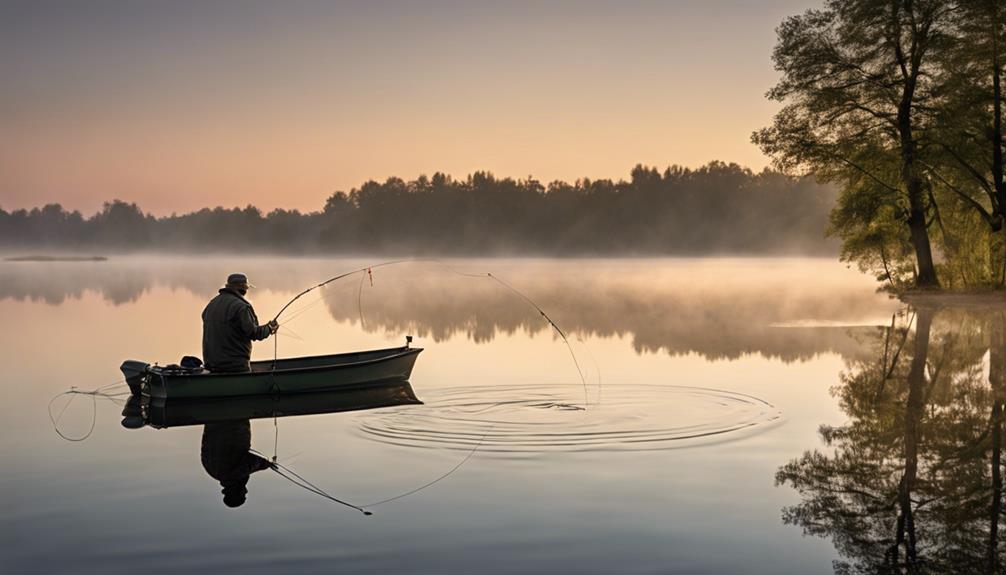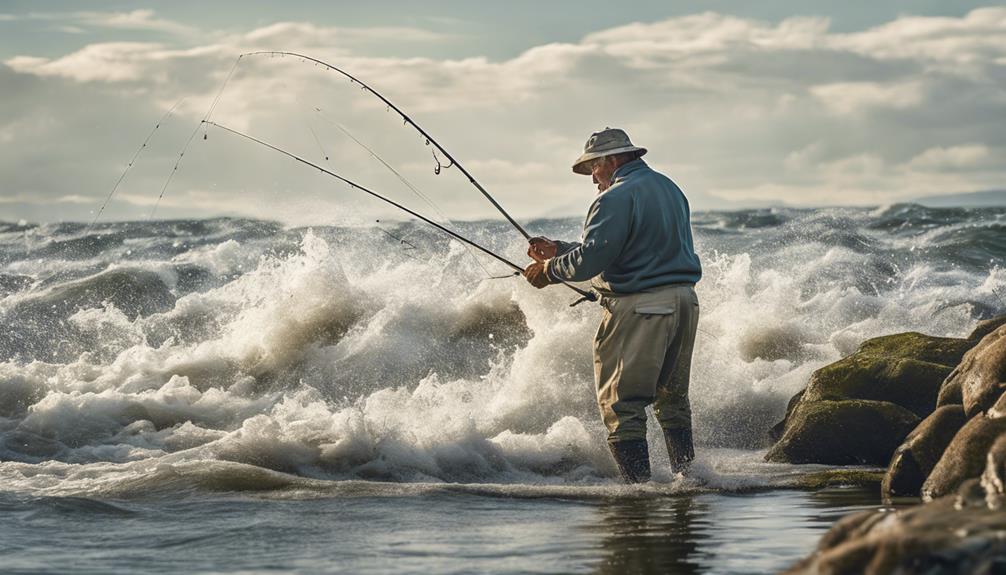When it comes to beginner surf fishing, think of it as mastering the basics before diving into the deep end of the ocean. Imagine yourself standing on the shoreline, waves crashing at your feet, rod in hand, the thrill of the catch within reach.
But how do you go from novice to adept in this aquatic pursuit? Let's break down some fundamental techniques that will have you reeling in those coveted fish from the surf in no time.
Proper Equipment Selection
When choosing your equipment for surf fishing, focus on selecting reliable gear suited to your skill level and target species. Starting with tackle essentials, ensure you have the basics: a sturdy fishing rod, a reliable reel, strong fishing line, various weights and sinkers, a selection of hooks, and appropriate bait. These tackle essentials are the foundation of your surf fishing gear and will help you be prepared for a variety of fishing situations.
Rod selection is crucial when it comes to surf fishing. Consider the length, power, and action of the rod based on your fishing location and target species. For beginners, a medium to medium-heavy rod around 9-12 feet in length is a good place to start. This length allows for longer casts while still providing the strength needed to reel in larger fish often caught in surf fishing environments. Additionally, choose a rod with a fast action tip to help you detect bites more easily, especially in rough surf conditions where visibility can be limited.
Understanding Tides and Currents
To optimize your surf fishing success, understanding tides and currents is essential. When planning your fishing trip, make use of tide charts to determine the best times to fish. Fishing during the incoming tide is generally more productive as it brings baitfish closer to shore, attracting larger predatory fish. Conversely, during the outgoing tide, fish tend to move towards deeper waters. By aligning your fishing schedule with the tides, you increase your chances of a successful catch.
Moreover, familiarize yourself with the current patterns in the area where you plan to fish. Different locations have varying current strengths and directions that can affect your fishing experience. Strong currents may disperse baitfish, making it harder for you to attract fish. In contrast, calmer currents can concentrate baitfish in specific areas, drawing in more predators. Understanding these current patterns allows you to position yourself strategically along the shore for optimal surf fishing.
When combining your knowledge of tide charts and current patterns, you can adapt your fishing techniques to suit the conditions of the day. Being aware of how tides and currents influence surf fishing won't only improve your catch rates but also enhance your overall fishing experience. So, before heading out, take the time to study the tide charts and observe the current patterns to make the most out of your surf fishing adventure.
Choosing the Right Bait
For optimal surf fishing success, selecting the right bait is crucial. The type of bait you choose can significantly impact your fishing success. When considering bait options, think about the species you're targeting and the conditions of the surf. Fresh bait tends to work best, so if possible, opt for live bait such as shrimp, sand fleas, or minnows. These baits are enticing to fish and can increase your chances of a successful catch.
Bait presentation is another key factor in attracting fish. Make sure your bait looks natural in the water to entice bites. Avoid overcrowding the hook with bait, as this can deter fish. Instead, aim for a natural presentation that mimics how baitfish move in the water. This can make your bait more appealing and increase your chances of a bite.
If you plan on longer trips, bait preservation is essential. To keep your bait fresh, consider using bait containers or coolers with ice packs to maintain the ideal temperature. This is especially important for perishable baits like squid or cut bait. By preserving your bait properly, you can ensure it stays fresh throughout your fishing excursion, giving you more opportunities to attract fish and improve your chances of a successful catch.
Casting Techniques for Beginners
Selecting the right casting technique is essential for beginner surf fishers looking to improve their skills and increase their chances of a successful catch. When starting out, it's crucial to focus on grip adjustments and line control. Your grip on the fishing rod should be firm but not too tight, allowing you to cast smoothly and with control. Experiment with different grips to find what works best for you, ensuring you can cast comfortably for extended periods.
For beginners, mastering distance casting and accuracy techniques is key. To cast for distance, practice your casting motion to generate more power. Remember to release the line at the right moment to achieve maximum distance. Accuracy techniques involve aiming for specific spots in the water where fish are likely to be. Practice casting towards targets to improve your accuracy over time. Adjust your casting angle and strength based on wind conditions and the weight of your bait to ensure precise placements.
Identifying Suitable Fishing Spots
When scouting for suitable fishing spots, keep an eye out for areas with underwater structures that attract fish. To maximize your chances of a successful surf fishing experience, consider the surf conditions and conduct thorough research on the area you plan to fish. Surf conditions play a significant role in determining where the fish will be located. Look for spots where waves break over sandbars or rocky outcrops, as these areas often attract baitfish and predatory species.
Local knowledge can be invaluable when identifying prime fishing locations. Seek advice from experienced anglers or locals familiar with the area. They can provide valuable insights into where the fish are likely to gather based on the time of day, tide movements, and weather conditions. Additionally, local anglers can offer tips on specific bait and tackle that work best in the area.
Before heading out, take the time to research potential fishing spots. Online forums, fishing websites, and local fishing reports can provide valuable information on where fish have been biting recently. Pay attention to details such as water temperature, currents, and the presence of baitfish, as these factors can help you narrow down your search for suitable fishing spots. By combining research with local knowledge and an understanding of surf conditions, you can increase your chances of finding the perfect fishing spot for a successful surf fishing outing.
Patience and Persistence
Developing patience and persistence is crucial for surf fishing success, as it often takes time and perseverance to reel in the big catch. When you're out surf fishing, remember these key points to help you stay focused and increase your chances of a successful fishing excursion:
- Practice Consistency: Consistency in your approach to surf fishing can make a significant difference. This means regularly dedicating time to honing your skills, understanding the behavior of the fish in different conditions, and consistently trying out new techniques. By practicing consistently, you'll improve your chances of a good catch.
- Mental Preparation: Surf fishing can sometimes be a waiting game, and having the mental fortitude to stay patient during slow periods is essential. Mentally prepare yourself for the possibility of spending long hours without immediate results. Visualize success, stay positive, and maintain focus even when the fish aren't biting.
- Stay Persistent: Persistence is key in surf fishing. Keep trying different baits, adjusting your casting technique, and exploring new fishing spots. Remember that each fishing trip, whether successful or not, is a learning opportunity. By staying persistent and not giving up easily, you increase your chances of landing that prized fish.
Safety Tips for Surf Fishing

As you gear up for your surf fishing adventures, ensuring your safety should be a top priority to fully enjoy the experience. When hitting the shores for some surf fishing action, it's crucial to follow beach etiquette to respect other anglers and beachgoers. Keep a safe distance from swimmers and sunbathers, and always clean up after yourself to leave the beach as pristine as you found it.
Equipping yourself with essential gear isn't just about catching fish; it also plays a significant role in keeping you safe. Make sure you have a reliable life vest, polarized sunglasses to reduce glare, and sturdy footwear to navigate the sandy terrain comfortably. Additionally, a first aid kit can come in handy for minor injuries that may occur during your fishing expedition.
Weather awareness is paramount when surf fishing. Keep an eye on the forecast and be prepared to act accordingly. Sudden changes in weather can be dangerous, so having emergency protocols in place is vital. If lightning is spotted or a storm approaches, it's best to pack up and seek shelter immediately. Always prioritize your safety over your fishing goals.
Cleaning and Maintenance of Gear
To ensure your gear remains in top condition for successful surf fishing outings, regular cleaning and maintenance are essential. Proper care not only prolongs the life of your equipment but also ensures optimal performance when you're out on the water.
Here are some key tips for cleaning and maintaining your gear:
- Gear storage: After each fishing trip, make sure to rinse off all your gear, including rods, reels, and tackle, with fresh water. Saltwater can cause corrosion, so it's crucial to remove any salt residue. Allow everything to dry completely before storing to prevent mold or mildew growth. Consider using protective covers for rods and reels to shield them from dust and moisture during storage.
- Rod care: Inspect your fishing rods regularly for any signs of damage, such as cracks or loose guides. Clean the rod with a gentle soap and water solution, especially focusing on the handle and reel seat. Check and tighten reel seats and guides as needed. Avoid storing rods in high-temperature areas, as excessive heat can weaken the rod's integrity.
- Reel maintenance: Clean your fishing reels according to the manufacturer's instructions, as different types of reels may require specific care. Lubricate moving parts with reel oil or grease to ensure smooth operation. Check the drag system and spool for any debris or corrosion, and make adjustments as necessary for optimal performance.
Frequently Asked Questions
How Can Beginners Improve Their Timing and Coordination When Casting From the Shore While Surf Fishing?
To improve your timing and coordination when casting from the shore while surf fishing, focus on casting accuracy and line control. Keep practicing to hone your skills.
Work on proper bait presentation and hook setting techniques. Remember, consistency is key.
With dedication and persistence, you'll enhance your abilities over time. Keep at it and enjoy the process of mastering these essential skills for successful surf fishing adventures.
Are There Any Specific Techniques for Reeling in a Catch When Surf Fishing That Beginners Should Be Aware Of?
When surf fishing, bait selection and hook setting are crucial for reeling in a catch. Make sure to use the right surf fishing gear and techniques.
Pay attention to your rod tip for any bites, then swiftly set the hook by reeling in fast and lifting the rod. Keep a steady pace while reeling to avoid losing the fish.
Practice these techniques, and you'll improve your success rate in no time!
What Are Some Common Mistakes That Beginners Should Avoid When Surf Fishing From the Beach?
When surf fishing from the beach, you should be mindful of common mistakes to avoid. Proper bait selection and understanding tides are crucial for success.
Avoid casting too close to shore; instead, focus on distance casting to reach deeper waters.
Respect beach etiquette by keeping your area clean and being considerate of other anglers.
How Can Beginners Effectively Read the Water and Waves to Determine Where to Cast Their Line While Surf Fishing?
To effectively read the water and waves for surf fishing, pay attention to wave patterns, tides, wind direction, and currents.
Waves breaking further out indicate sandbars or deeper water, good for fish. Fish tend to follow the tides, so fish closer during incoming tide.
Wind direction can push baitfish closer to shore, attracting larger fish. Look for rip currents and calm areas to find feeding fish.
Are There Any Tips for Handling and Releasing Fish Properly While Surf Fishing as a Beginner?
When handling fish while surf fishing, it's crucial to prioritize their well-being. Proper fish handling techniques like wetting your hands before touching them can help prevent damage to their protective slime.
For catch and release, always handle fish gently, avoid removing them from the water for too long, and release them back carefully.
Following these practices shows respect for the fish and maintains conservation efforts, promoting ethical fishing practices.
Conclusion
Overall, by selecting the right equipment, understanding tides and currents, choosing the right bait, mastering casting techniques, identifying suitable fishing spots, and practicing patience and persistence, you can improve your surf fishing skills as a beginner.
Remember to also prioritize safety, clean and maintain your gear regularly, and most importantly, enjoy the experience of being out in the surf and connecting with nature.
Keep practicing and you'll become a more skilled surf angler in no time!



